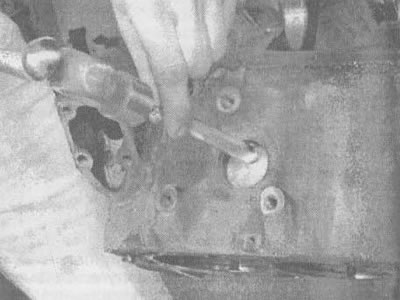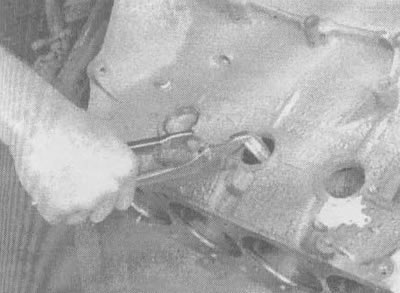2. Using a special scraper, remove all traces of gasket material from the cylinder block. Do not damage or scratch the mating surfaces of the gaskets.
3. Remove all caps and oil line screw plugs from the block. Usually the plugs are very tight - they may have to be drilled out and re-threaded. Use new plugs when reassembling the engine.
4. Remove the plugs from the cylinder block. To do this, drive one side of the cork into the block with a hammer and punch, then grab it with large pliers and pull it out (see illustrations).

15.4a. A hammer and a large punch can be used to remove plugs from their holes | 
15.4b. Remove the plug from the block with pliers |
5. If the engine is too dirty, it should be taken to an auto repair shop for cleaning.
6. After returning the unit from cleaning, clean all oil holes and lines again. Special brushes for these purposes can be purchased. Flush the channels with warm water until the water comes out clean; dry the unit thoroughly and wipe all machined surfaces with a light-coloured anti-corrosion oil. If you have a compressed air source, use it to speed up the drying process and blow out all oil holes and lines.
Attention! Wear protective goggles when using compressed air.
7. If the block is not too dirty or covered in deposits, you can clean it yourself with soapy water and a stiff brush. Take your time and do this job carefully. Regardless of the cleaning method used, be sure to carefully clean all oil holes and lines, dry the block thoroughly, and coat all machined surfaces with a coat of oil.
8. All threaded holes in the block must be clean to ensure that the required tightening torques are met during assembly. Turn each hole with an appropriately sized tap to remove rust, sealant residue or deposits and repair damaged threads (see illustration). If possible, use compressed air to clean the holes from the resulting contamination. The threads on the head bolts and main bearing cap bolts should also be cleaned.

15.8. All bolt holes in block (especially the bolt holes of the main bearing caps and head) must be cleaned, and the threads in them must be restored using a tap (at the end of the work, be sure to clean the holes from dirt)
9. Reinstall the main bearing caps and hand tighten the bolts.
10. After coating the sealing surfaces of the new plugs with Permatex N2 sealant, install the plugs in the cylinder block (see illustration). Make sure that they are guided correctly and that they are correctly planted; otherwise, leakage may occur. Special tools are available for this purpose, but a large socket with an outside diameter just enough to fit into the cork, a 1/2-inch pilot extension, and a hammer will do.

15.10. A large socket with extension can be used to guide new plugs into the holes
11. Apply non-hardening sealant (Permatex N2 or Teflon pipe seal) on the new oil line screw plugs and screw the plugs into the holes in the block. Make sure they are securely tightened.
12. If you are not going to assemble the engine right away, cover the engine with plastic wrap to keep it clean.
